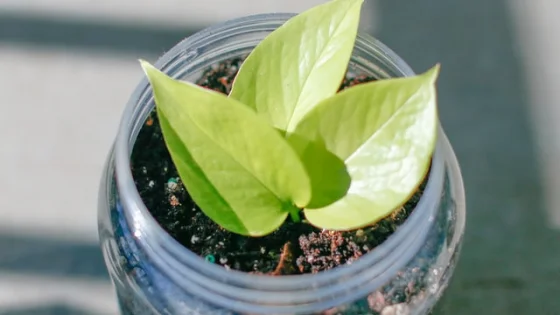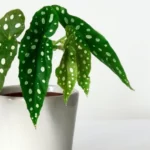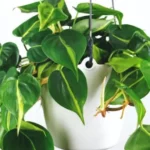Table of Contents
Caring for Neon Pothos
Neon Pothos, or Epipremnum aureum ‘neon,’ is originally a tropical plant, but its ability to survive as a houseplant, as well as its bright foliage, means that Neon Pothos is a popular houseplant even in more temperate regions.
Neon Pothos, when presented with the right conditions, has neon green leaves. The bright yellow-green really gives it a visual pop in the same way as many plants do with brightly colored flowers.
The Neon Pothos doesn’t flower as a houseplant, but it survives most conditions, and it takes just a little effort to achieve vines of neon green leaves as the plant thrives. This makes the Neon Pothos a fantastic choice for people who are new to caring to plants.
The Neon Pothos also does a good job of filtering toxins from the air, which makes it a good choice for an office or bathroom setting.
Helping Neon Pothos Thrive
The Neon Pothos can survive sub-optimal conditions better than a lot of tropical plants can. However, it does still have preferred conditions under which it’ll give the best growth and brightest foliage.
Ideal conditions for the Neon Pothos include bright (but not harsh) light, high humidity, and plenty of warmth.
However, this resilient little plant can still grow with dim or fluorescent light, normal humidity, and the lower end of comfortable indoor temperatures.
These things just make it grow a little more slowly, and it tends to lose the distinct, neon brightness.
Light Requirements
The Neon Pothos prefers bright, indirect light, as do most tropical houseplants. However, this plant can still be happy in dim light or even in artificial light.
It’s often recommended for office settings, as well as bathrooms and bedrooms, and the lower natural light in these settings is perfectly acceptable.
Sunlight that is too direct and unfiltered can scorch the leaves, so don’t put the Neon Pothos too near a window that gets a lot of direct sun, especially in summer and if you live in warmer climates.
In dimmer lighting, Neon Pothos may lose the vibrancy of its leaves and fade to more of an olive green.
Temperature Requirements
The Neon Pothos likes standard indoor temperatures, from around 60 degrees Fahrenheit to around 80 degrees Fahrenheit.
Unlike many plants, if presented with temperatures a bit outside that range, the Neon Pothos isn’t likely to die quickly.
Instead, lower temperatures limit new growth, and higher temperatures can result in faster growth that can cause poor aesthetics in a vining plant.
Soil Requirements
Standard, balanced potting soil is fine for the Neon Pothos. You can also look for soils that drain well; Neon Pothos can develop root rot if the soil remains too wet.
Humidity Requirements
The Neon Pothos enjoys high humidity but doesn’t require it. Extremely dry areas, such as desert climates, might need to introduce humidity, either with a humidifier or by keeping excess water nearby.
It’s good to try this if leaves start turning brown and dry.
If you have a room with particularly high humidity, such as the bathroom, the Neon Pothos may thank you for the humidity by growing a little better and a little perkier.
How to Water Neon Pothos
Neon Pothos likes its soil moist, but not actively wet. Depending on your climate and the time of year, you should water the Neon Pothos once every week or two.
Water near the soil, trying not to get water directly on the leaves. Make sure the top inch or so of soil is dry before watering it again.
Yellowing leaves can be an early indication of overwatering. If you see yellow leaves, double check that at least the top inch of soil is dry before watering, and make sure the pot is properly draining. Remember that too much moisture can lead to root rot.
How to Fertilize Neon Pothos
If you use a nutritious soil, Neon Pothos may not need any fertilizer. If it does, fertilize about once a month during the growing seasons of spring and summer (with early fall included in warmer climates).
Pruning Neon Pothos
Neon Pothos can grow quite large or long if allowed to, so much of the pruning of this plant is to keep it appropriate for the space available.
If more stem than leaf starts showing, you can prune the long vines and replant them even within the same pot. Vines growing without any leaves should generally be pruned.
Propagation of Neon Pothos
Neon Pothos is relatively easy to propagate. Take a cutting that includes at least one root node (the little brown bumps along the vine), and put it in water (with any leaves out of the water) or in a moist potting soil.
It can grow in water for some time, months if given the proper nutrients, though the longer it’s in water before being transferred to soil, the less likely it is to thrive in soil. Once it’s grown a bit of root, you can shift it from water to a pot.
Extra Tips for Neon Pothos Care
Pests and Diseases
Neon Pothos isn’t particularly prone to pests or diseases. As with other Pothos plants, it can develop root rot and may attract scales or mealybugs.
Ridding Neon Pothos of Root Rot
Prevention is really the key to avoiding root rot; it’s difficult to help a plant recover from this. Be sure not to overwater your Neon Pothos, and make sure the top inch of soil is dry before adding more water.
Make sure that your pot has good drainage and that drainage holes aren’t blocked.
Ridding Neon Pothos of Infestations
If scales, mealybugs, or any other pest finds its way to your plants, the best bet is to manually remove the infestation, then wipe down the plant with rubbing alcohol or an insecticide.
You’ll also want to check any other nearby plants, and it may be a good idea to treat them preemptively.
Toxicity
Neon Pothos is toxic to pets and shouldn’t be ingested.
Quick Reference
- Light: Bright & indirect
- Temperature: 60 to 80 degrees Fahrenheit
- Soil: Balanced potting soil
- Humidity: Average to high
- Water: Once every 1-2 weeks
- Pruning: As needed, mostly for aesthetics



